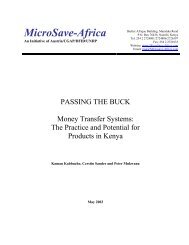You also want an ePaper? Increase the reach of your titles
YUMPU automatically turns print PDFs into web optimized ePapers that Google loves.
<strong>DAI</strong>’s project <strong>of</strong>fice<br />
in Banda Aceh,<br />
Indonesia, was swept<br />
away in the tsunami<br />
<strong>of</strong> 2004, but <strong>DAI</strong>’s<br />
SWIFT team helped to<br />
coordinate the relief<br />
effort within days.<br />
92<br />
Defense and Democracy<br />
The changing landscape <strong>of</strong> U.S. development<br />
policy amounted to something <strong>of</strong> a seismic<br />
shift. It shattered a unitary government interface<br />
into one with many facets and saw USAID move<br />
from more conventional economic development<br />
to approaches that more forthrightly supported<br />
free markets and political democracy. After<br />
a crisis, USAID was more than ever before<br />
committed to rebuilding on the basis <strong>of</strong> liberal<br />
institutions, sometimes even more than the host<br />
country.<br />
It was a real seismic shift that provided the best<br />
example <strong>of</strong> this. The huge earthquake hit early<br />
on the morning <strong>of</strong> December 26, 2004. A few<br />
minutes later a towering tsunami hit the city <strong>of</strong><br />
Banda Aceh on the northern tip <strong>of</strong> Sumatra,<br />
killing some 130,000 people and devastating<br />
the province. In the aftermath, the U.S. Government,<br />
its reputation in Asia clouded by the Iraq<br />
war, was eager to lead relief and reconstruction<br />
efforts and bring democracy to the region. This<br />
was difficult, because the area had been the<br />
epicenter <strong>of</strong> political separatism and a brutal<br />
government response, and long <strong>of</strong>f-limits to<br />
tourists and foreign governments.<br />
But <strong>DAI</strong> was there. Its SWIFT team had been<br />
implementing USAID’s Support for Peaceful<br />
Democratization program since the end <strong>of</strong><br />
Indonesian authoritarian rule in 1998. Although<br />
the Banda Aceh project <strong>of</strong>fice was swept away<br />
by the tsunami, <strong>DAI</strong> staff were soon coordinating<br />
with U.S. and international relief agencies.<br />
Within days, the <strong>DAI</strong> team was identifying areas<br />
<strong>of</strong> need and providing grants to reconstruct<br />
and rehabilitate not only the Sumatran physical<br />
infrastructure but its social and economic infrastructure,<br />
as well. In two months, <strong>DAI</strong> channeled<br />
$3.8 million into the local economy, more than<br />
half <strong>of</strong> it going to Aceh-based nongovernmental<br />
agencies.<br />
Whether the company was mediating between<br />
pro- and anti-government forces in Indonesia or<br />
working within a combat zone in Iraq, security<br />
concerns came ever more squarely into the <strong>DAI</strong><br />
spotlight. While the safety <strong>of</strong> its staff remained<br />
its paramount concern, walking away from such<br />
hotspots was not an option: the development<br />
needs were too great, and <strong>DAI</strong>’s contribution<br />
was too valuable. Its Iraqi stabilization work in<br />
Sadr City, Talafar, and Fallujah, for example, was<br />
considered so good that it was cited in the U.S.<br />
military’s Counterinsurgency Field Manual as a<br />
model for the “clear, hold, and build” strategy.



